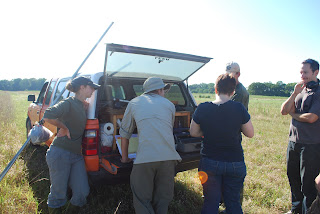I’ve been sitting at this desk, off and on, for the past week, pulling all nighters and writing what seems to be an endless procession of archaeological reports. But half the time I’m not really here. I’m actually on a hillside in New Jersey, in the winter of 1778-1779. It’s the middle of the American Revolution, and General Henry Knox and his artillery have stripped the hillside above the little village of Pluckemin and created a small city. They’ve cut down the trees to build barracks, an academy, warehouses, a laboratory for munitions, and workshops for gunsmiths, blacksmiths, carpenters, tinsmiths, and other craftsmen.
What blows my mind is that they built all of this in only two months! How did they do it? What were they thinking? What was life like for these people, men, women, and children?
 |
A South West Perspective View of the Artillery Barracks, Pluckemin N. Jersey 1779 – by Capt. John Lillie
(Courtesy of Morristown National Historical Park) |
In my schizoid, time traveling world, I’m also flitting back to the 1980s, when I led a team of archaeologists and historians in uncovering the archaeological remains of Knox’s military city. We mapped stone mounds that held the remnants of fireplaces and chimneys, as well as lines of stone where walls once stood. We plotted artifacts, such as nails, refuse, and gun parts that showed us what went on inside the buildings. Initially, we were simply trying to save this forested slope and its historical remains from residential development. But the project quickly grew into a major mystery story.
• Why was so little known about this winter, which was overshadowed by the previous winter at Valley Forge? Crack open any history of the war, and you’ll find no more than a passing mention of the winter of 1778-1779.
• Why did the soldiers seem so well-supplied and well-fed? The perpetual image is of shivering starving soldiers, huddled in make-shift cabins. But in the Pluckemin barracks we found plenty of bone, shell, and the latest ceramics from England, so they weren’t eating their shoes.
• How is that officers were drinking tea from Chinese export porcelain and inviting the local ladies to visit, a dozen or more at a time? Hundreds of pieces of porcelain were found in a dump behind their barracks, along with broken wine bottles. It sure looks like they were having a good time! They also held a ball, with dancing and fireworks…a real disconnect with our images of bloody footprints in the snow.
• How is it that these men built timber-framed barracks, one of them more than 450 feet long, rather than the crude log cabins that we usually hear about? A guy named John Lillie, a captain there, drew a picture of the barracks; it matched perfectly with what we saw in the field, and we found nails, pane glass and plenty of other evidence of sophisticated construction.
 |
| Pluckemin refuse dump with oyster shell, bone, and porcelain |
 |
| Chinese porcelain – tea cup fragment |
 |
| Nails – framing, flooring, finishing |
 |
| Valley Forge |
Something wasn’t right…this wasn’t what we expected.
During a decade of excavations at the site, the picture that emerged was of an army that got its act together, an army doing a great job of emulating its British cousin, the most potent military force in the world. At Pluckemin, Knox and Washington built an academy (the nation’s first – sorry, West Point!) and trained officers. The workshops repaired arms, and the Continental Army was resupplied out of the Pluckemin warehouses. It’s a great story, a success story that we don’t often hear. But it certainly explains our eventual victory more convincingly than resorting to “divine providence” (and of course the French had a small hand in it, too!).
 |
| Uniform button |
In 1989, I left the area and took a job at the University of Maryland (tenure track positions for archaeologists were hard to find then, too). Unfortunately, the amazing collection of artifacts we amassed over the 1980s sat in limbo. Nobody wanted them to leave New Jersey, but there was no-one there to pursue the work.
Fast forward to 2008. Knowing that the archaeological collection still has much to tell us, we formed a partnership to rejuvenate the project. Working on the analysis of this amazing collection are Washington College, Monmouth University, and a Trenton-based cultural resource management company, Hunter Research. Coordinating the effort is the Friends of the Jacobus Vanderveer House, in Bedminster, New Jersey. That’s the house that Knox lived in for the winter, with his family. The first phase of the work was funded by the Somerset County Cultural & Heritage Commission. We’ve been chipping away at the artifact collection, building a database, creating a modern GIS, and Washington College students have created a first-generation, three-dimensional model of the camp based on the archaeology.
I’m tasked with writing up what we’ve learned so far. And time traveling.
Stay tuned as we continue this project and post our reports on line. You can learn more, and fly over the reconstructed sites, via the following web sites:
J. Vanderveer House
A short history of the site
A teaser for the 3-D project
A fly-over of the camp as we've reconstructed it
A short demo on how the barracks were built in the computer
WC Archaeology Lab
WC GIS Lab
Dr. John L. Seidel is the Director of the Center for Environment & Society. When he’s not time traveling, he teaches at Washington College and works with Center staff, students, faculty and the community on the sustainability issues of the present.




















































